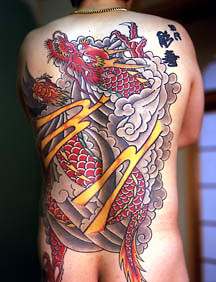


Horimono (彫り物, 彫物, literally carving, engraving) is a word used to describe irezumi (Japanese Tattooing) or to describe the carving of images into a sword blade.
Irezumi
The Japanese word irezumi (入れ墨, 入墨, 文身, 剳青, 黥 or 刺青) refers to the insertion of ink under the skin to leave a permanent mark, in other words, tattooing. The term irezumi traditionally refers to marks made to indicate a convicted criminal.[1] Such marks are not the skillful designs known as the Japanese style tattoo, so while both terms are often used interchangeably, horimono is generally considered the more polite term.
Tattooing for spiritual and decorative purposes in Japan is thought to extend back to at least the Jōmon period (approximately 10000 BCE). Some scholars have suggested that the distinctive cord-marked patterns observed on the faces and bodies of figures dated to that period represent tattoos, but this claim is by no means unanimous. There are similarities, however, between such markings and the tattoo traditions observed in other contemporaneous cultures.
At the beginning of the Meiji period (1868-1912), the Japanese government, wanting to protect its image and make a good impression on the West, outlawed tattoos[citation needed], and irezumi took on connotations of criminality. Nevertheless, fascinated foreigners went to Japan seeking the skills of tattoo artists, and traditional tattooing continued underground.
Tattooing was legalized by the Occupation forces in 1945, but has retained its image of criminality. For many years, traditional Japanese tattoos were associated with the yakuza, Japan's notorious mafia, and many businesses in Japan (such as public baths, fitness centers and hot springs) still ban customers with tattoos.
Japanese swords
In this context, the terms horimono or chōkoku[2] (彫刻, "sculpture") are used to describe the carving of images into Japanese swords including katana and tanto. The carving is used mostly for ceremonial blades due to the inherent weakness in a carved blade[3]. The engravings are created by a chōkokushi (彫刻師), also called a horimonoshi (彫物師, "engraver"). These come in a huge variety of designs including kozumi (claws), kusa kurikara (草倶利伽羅) (Arabesque style), Munenagabori (created in Munenaga), rendai (lotus pedastal), tokko (a type of Indian sword), fruit, dragons, and many others.
Source : http://en.wikipedia.org/wiki/Horimono





